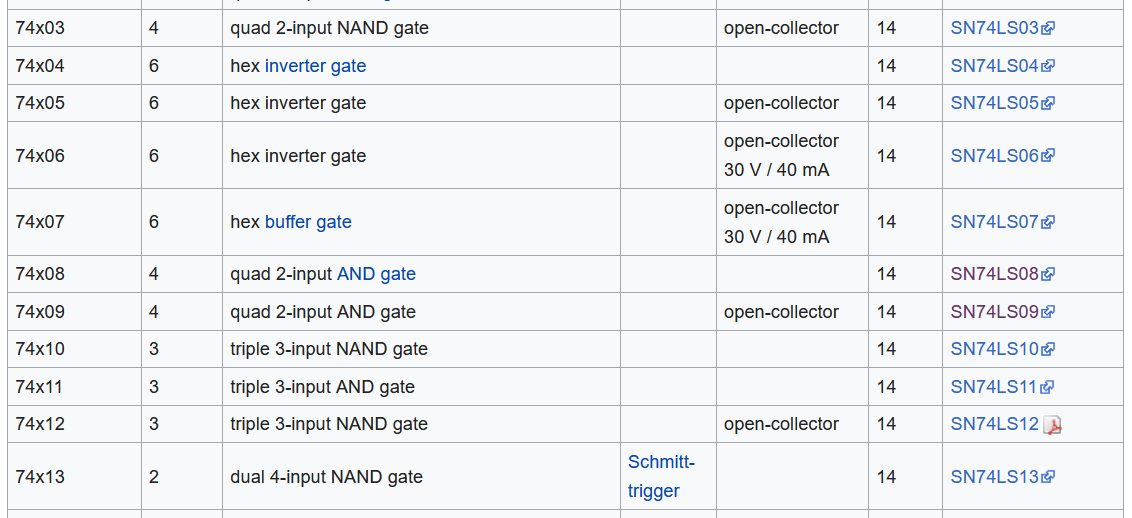In this article, I want to go over a couple of things to consider when choosing parts for a digital circuit. I’ll discuss different hardware characteristics of various integrated circuits as well as talk about my own method for selecting parts when I want to build a digital circuit.
Before Designing a Complicated Circuit
Before I build a complex digital circuit, I always take a look at this table, which lists all official 7400 series ICs, regardless of their current availability.

This list allows me to make sure that the circuit I want to build doesn’t already exist. Many standard functions are already implemented in a single IC, and this way can make sure that you save your time and money.
The list also links an appropriate datasheet for each component, and it describes the most important aspects of each device.
Choosing Parts By Their Operating Voltage
Some devices, like the 7400 Quad-NAND IC, operate safely on a very specific supply voltage (which is 4.75V – 5.25V), while others, like the 74288 1024-bit PROM, may require a higher supply voltage for certain operations.
However, that’s the exception. In reality, it’s down to the question of whether your circuit has to work with up to 5V or with a lower voltage (like 3.3V). Usually, the components can withstand a slightly higher voltage without getting damaged. However, it’s not recommended to run the devices under those circumstances for a prolonged period of time.
Look at the Output Capabilities of Each Device
Next, I look at the output of each IC. If you examine the output column of the list mentioned earlier, you’ll find that the majority of devices either have nothing stated, a three-state output, an open-collector, or a driving output. Let me quickly summarize those types.
No Info Supplied
For this table, “No Info Supplied” means that the device has a regular push-pull (totem-pole) output that can be used to drive other 7400 inputs but can not be used to draw a lot of current. Furthermore, you can most likely indirectly connect the outputs of this IC to the outputs of other devices.
Three-state Output
Devices with a three-state (sometimes also called tri-state or Z-state) output have a special high-impedance mode that allows you to connect their outputs to the outputs of other ICs. This is especially useful when you want to build a data-bus that connects multiple devices.
Open-collector Output
An open-collector output in an IC is either connected to ground or it’s open, meaning that every output pin of a device, with open-collector outputs, will require external pull-up resistors. Consult the datasheet of the specific device for details.
Driver Output
ICs with driver outputs can be used to supply enough power to drive large loads, including (but not limited to) motors, powerful LEDs, and electronic tubes.
Analog Output
Some digital ICs have one or multiple analog outputs. Digital to analog converters are one example.
Maximum Clock Frequency
Many digital circuits operate synchronously, meaning they have some type of shared clock signal. Make sure that all the components you choose can run on the frequency your clock provides.
You also have to make sure to adhere to the timing constraints of a manufacturer (for example, the propagation delay of logic gates or the setup time of a memory IC). The higher the frequency, the easier it is to run into problems.
Other Characteristics to Consider
Some areas, like the automotive, medical, and military industry, have specific conditions in which the ICs have to work. If your project also has certain rules that must be met, make sure that all your components are rated appropriately.
Some models of an IC can, for example, only operate between 0° and 70°C, while others work between -55 and 125°C.

Carefully Read All Datasheets
Luckily, many standard functions are already implemented in readily-available ICs, so you don’t have to reinvent the wheel. When choosing ICs, make sure that they can all operate at the same voltage.
Other important factors to consider are the output-types of the ICs and their absolute maximum ratings (speed, temperature, voltage, …). You can only ensure these factors by carefully reading through the necessary datasheets. It can be a bit dry to read, but it saves time and money in the long run!


